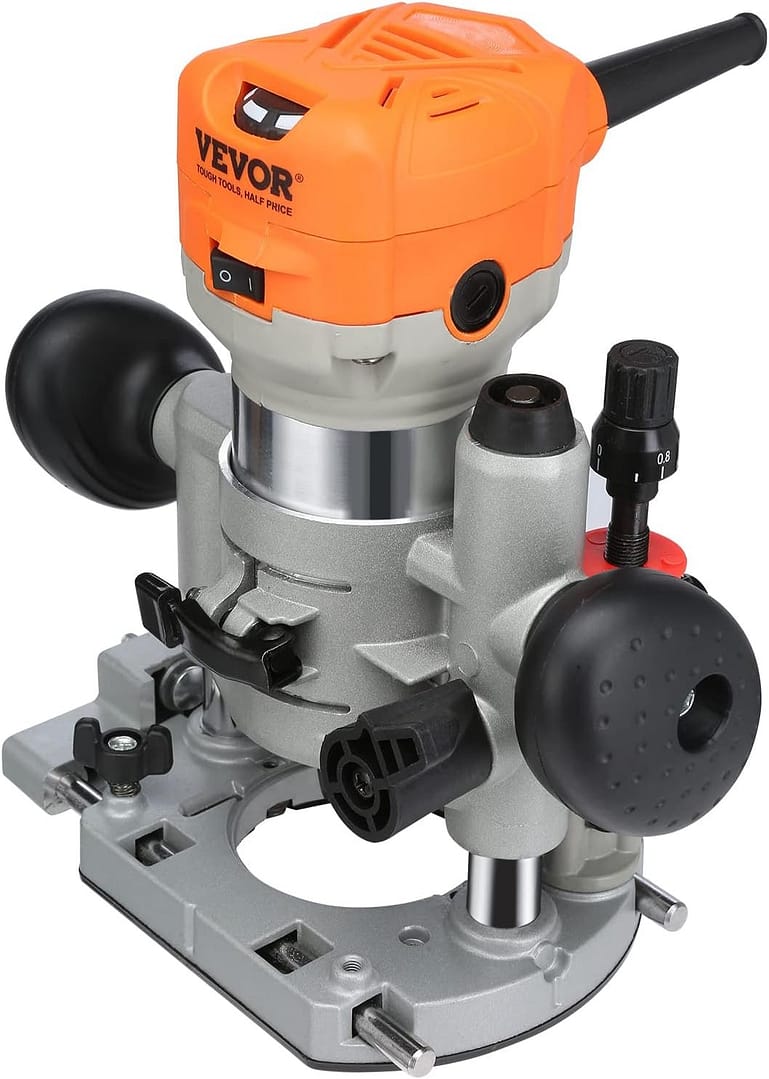Are you a woodworking enthusiast looking to invest in a router but unsure of what size to get? Look no further! In this article, we will explore the various sizes of woodworking routers and help you determine which one is best suited for your needs. Whether you are a beginner or a seasoned professional, we’ve got you covered with all the information you need to make an informed decision. So, let’s get started and find the perfect woodworking router for you!
1. Factors to consider
When choosing a woodworking router, there are several factors that you should consider to ensure that you select the best router for your needs. These factors include project requirements, available workspace, budget constraints, and operator experience level. By taking these factors into account, you can make an informed decision and find a woodworking router that will meet your specific needs and preferences.
1.1 Project requirements
The first factor to consider when choosing a woodworking router is your specific project requirements. Different projects have different demands, and it’s important to choose a router that is capable of meeting those demands. Consider the size and complexity of your projects, as well as the type of materials you will be working with. This will help determine the power, size, and features that are necessary for your router.
1.2 Available workspace
Another important factor to consider is the amount of available workspace you have. Woodworking routers come in various sizes, and it’s essential to choose one that will fit comfortably in your workspace. Measure the dimensions of your work area and compare them to the router’s dimensions to ensure a proper fit. Additionally, consider the maneuverability and portability of the router if you anticipate needing to move it frequently.
1.3 Budget constraints
Budget is often a significant consideration when purchasing any tool or equipment, and woodworking routers are no exception. Determine your budget and explore the options that fall within that range. It’s important to note that while cost is a factor, it should not be the sole determining factor. Consider the long-term value and durability of the router, as well as its specific features and capabilities, when evaluating its worth.
1.4 Operator experience level
The experience level of the operator should also be taken into account. If you are a beginner, it may be more suitable to choose a router that is easier to use and has safety features that make it more forgiving for beginners. However, if you have experience working with routers, you may opt for a model with more advanced features and capabilities. Consider your skill level and choose a router that matches your expertise.
2. Compact Routers
2.1 Uses
Compact routers are smaller in size and are often used for light-duty tasks and intricate woodworking. They are ideal for projects that require precision, such as trimming, shaping edges, or creating decorative details. Compact routers are also commonly used for joinery work, such as mortising and dovetailing.
2.2 Advantages
One of the key advantages of compact routers is their portability and ease of maneuverability. They are lightweight and can be easily transported from one workspace to another. Compact routers are also generally less expensive compared to larger routers, making them a cost-effective choice for those on a budget. Additionally, their smaller size allows for greater control and precision in executing delicate woodworking tasks.
2.3 Disadvantages
Despite their advantages, compact routers do have some limitations. Due to their smaller size, these routers typically offer lower horsepower compared to their larger counterparts. This can affect their performance and speed, making them less suitable for heavy-duty tasks or working with harder materials. Compact routers may also have a narrower range of bit compatibility compared to larger routers.
2.4 Suitable Projects
Compact routers are best suited for smaller-scale projects and tasks that require intricate detail and precision. They excel in applications such as edge trimming, decorative woodworking, and joinery work. If you primarily work on small projects or have limited workspace, a compact router may be the best choice for you.

3. Mid-size Routers
3.1 Uses
Mid-size routers offer a balance between power and versatility, making them suitable for a wide range of woodworking projects. They can handle both light-duty and medium-duty tasks, such as routing grooves, making dados, or shaping larger edges. Mid-size routers are commonly used by both professionals and hobbyists due to their versatility.
3.2 Advantages
One of the main advantages of mid-size routers is their increased power compared to compact routers. They typically offer higher horsepower, allowing for faster and more efficient routing. Mid-size routers also offer a wider range of bit compatibility, giving you more options for different woodworking applications. Additionally, many mid-size routers come with adjustable speed settings, providing greater control over the routing process.
3.3 Disadvantages
One potential drawback of mid-size routers is their larger size and weight compared to compact routers. While they still offer a good level of maneuverability, they may be less portable and more cumbersome to transport. The larger size may also require more workspace and may not be suitable for those with limited room. Additionally, mid-size routers may come with a higher price tag compared to compact routers.
3.4 Suitable Projects
Mid-size routers are a versatile choice for a wide range of woodworking projects. They are suitable for both small-scale and medium-scale tasks, making them an excellent option for hobbyists and professionals alike. Whether you need to make grooves, dados, or shape larger edges, a mid-size router can meet your needs.
4. Full-size Routers
4.1 Uses
Full-size routers are the most powerful and heavy-duty option available. They are designed for handling demanding woodworking tasks, such as routing large profiles, working with hardwoods, or shaping heavy materials. These routers are commonly found in professional workshops or used by experienced woodworkers who require maximum power and capability.
4.2 Advantages
The main advantage of full-size routers is their high horsepower and cutting capability. They can easily handle heavy-duty tasks and work with harder materials without losing speed or efficiency. Full-size routers also offer a vast range of bit compatibility, allowing for maximum versatility in woodworking applications. Many full-size routers come with advanced features such as electronic speed control and dust collection systems.
4.3 Disadvantages
The major disadvantage of full-size routers is their size and weight. These routers are much larger and heavier compared to compact and mid-size routers. This can make them less maneuverable and more challenging to transport, especially for those with limited strength or workspace. Additionally, full-size routers tend to be more expensive due to their increased power and features.
4.4 Suitable Projects
Full-size routers are best suited for heavy-duty woodworking projects or tasks that involve working with dense or tough materials. If you frequently work with hardwoods, large profiles, or engage in professional-level woodworking, a full-size router is the ideal choice for you.

5. Fixed Base vs. Plunge Base
5.1 Fixed Base Routers
5.1.1 Uses
Fixed base routers are designed for tasks that require stability and precision. They are commonly used for edge profiling, grooving, and dadoing. The fixed base provides a steady platform for accurate cuts and allows for easy adjustments of cutting depths.
5.1.2 Advantages
One of the main advantages of fixed base routers is their simplicity and ease of use. They are typically more user-friendly for beginners, providing a stable and predictable cutting experience. Fixed base routers are also generally more compact and lighter in weight compared to plunge base routers, making them easier to handle and maneuver.
5.1.3 Disadvantages
Fixed base routers have limitations in terms of versatility. They are primarily designed for edge routing and may not be suitable for tasks that require plunge cutting or working on the interior of a workpiece. The inability to plunge can limit the scope of projects that can be done with a fixed base router.
5.2 Plunge Base Routers
5.2.1 Uses
Plunge base routers are best suited for tasks that require plunge cutting, such as cutting mortises or creating stopped dadoes. They are also often used for tasks that involve working on the interior of a workpiece, such as routing out recesses or creating inlays.
5.2.2 Advantages
The main advantage of plunge base routers is their ability to plunge into the workpiece, allowing for greater versatility in routing tasks. They offer more flexibility in terms of cutting depths and allow for precise and controlled plunges. Plunge base routers are often preferred when working on more complex projects that require a variety of cutting techniques.
5.2.3 Disadvantages
One potential disadvantage of plunge base routers is their complexity compared to fixed base routers. They may require a bit more skill and experience to operate effectively, especially when it comes to plunge routing. Plunge base routers are also typically larger and heavier than fixed base routers, which may make them less suitable for those with limited workspace or mobility.
6. Horsepower (HP) Considerations
6.1 Understanding HP Ratings
Horsepower (HP) is an important consideration when choosing a woodworking router, as it determines the power and cutting capability of the machine. HP refers to the amount of work the router’s motor can perform within a specific period. Generally, higher horsepower means more cutting power and the ability to handle tougher materials.
6.2 Determining Required HP
To determine the required horsepower for your woodworking projects, consider the types of materials you will be working with and the complexity of the tasks. Hardwoods and dense materials require more power, while softer materials may not require as much. Additionally, heavier cuts or deep plunges will require higher horsepower to maintain efficiency and prevent strain on the motor.
6.3 Impact of HP on Performance
The horsepower rating of a router directly impacts its performance. Higher horsepower routers can handle larger bits and cut through materials more efficiently. They provide better cutting speeds and are less likely to bog down under load. However, it’s important to consider that higher horsepower often means a larger and heavier router, which may not be suitable for all users or projects.
6.4 Balancing Power and Weight
Balancing power and weight is crucial when choosing a woodworking router. While higher horsepower routers offer more cutting power, they are often heavier and bulkier. Consider the balance between power and maneuverability to ensure that the router is comfortable to handle and suits your specific projects. It’s important to find a router with adequate horsepower for your needs without sacrificing ease of use.
7. Variable Speed Capability
7.1 Importance of Variable Speed
Variable speed capability is a valuable feature to have in a woodworking router. It allows you to control the speed of the router’s motor, which is important when working with different types of materials, bit sizes, or when executing specific cuts. Different speeds are required to achieve optimal performance and prevent burning or chattering of the material.
7.2 Benefits of Adjustable Speed
Having adjustable speed settings offers several benefits. Slower speeds are typically preferred when working with hardwoods or larger bits, as they reduce the risk of overheating or causing tear-out. Higher speeds are suitable for softer woods or smaller bits, as they provide better control and precision. Being able to adjust the speed allows you to fine-tune the router’s performance to match the specific needs of your project.
7.3 Projects Requiring Variable Speed
Variable speed capability is particularly valuable for projects that involve a range of materials and bit sizes. Working with a variety of hardwoods, softwoods, or composite materials may require different speeds to achieve optimal results. Additionally, when using large bits, intricate profile bits, or performing delicate cuts, being able to adjust the speed provides greater control and reduces the risk of accidents or mistakes.
8. Ergonomics and Comfort
8.1 Grip and Handle Design
The ergonomics and comfort of a woodworking router are essential factors to consider, especially if you anticipate using the router for extended periods. Pay attention to the grip and handle design of the router, as it should be comfortable to hold and provide a secure grip. Look for routers with ergonomic handles, rubberized grips, or vibration-absorbing features to minimize hand fatigue and improve overall comfort.
8.2 Overall Router Weight
The overall weight of the router can also impact its ease of use and comfort. Heavier routers may be more challenging to maneuver and control, especially for extended periods of use. Consider your own comfort level and physical strength when selecting a router. If you anticipate working on large projects or using the router for long periods, a lighter model may be more suitable.
8.3 Vibration and Noise Reduction
Reducing vibration and noise is another ergonomic consideration when choosing a woodworking router. Excessive vibrations can lead to hand fatigue and affect the accuracy of your cuts. Look for routers with built-in features such as vibration-dampening systems or anti-vibration handles to minimize the impact of vibrations on your hands. Additionally, consider routers that have noise reduction features to create a more comfortable work environment.
9. Additional Features
9.1 Spindle Lock
A spindle lock is a useful feature that allows for easier and safer bit changes. It locks the spindle in place, preventing it from rotating while you loosen or tighten the collet nut. This feature eliminates the need for a second wrench and provides a secure hold on the bit, reducing the risk of accidents or slippage during the bit changing process.
9.2 Dust Collection
Dust collection is an important consideration for both cleanliness and health reasons. Routers generate a significant amount of debris and fine dust during the cutting process. Look for routers that have built-in dust collection systems or compatibility with dust collection attachments. This feature helps keep your workspace clean, improves visibility, and protects you from inhaling potentially harmful dust particles.
9.3 Bit Compatibility
The compatibility of the router with different bit sizes and shank types is crucial. Make sure the router can accommodate the bits you commonly use for your projects. Many routers come with both 1/4-inch and 1/2-inch collets, providing increased versatility and compatibility with a wider range of bits. Check the router’s specifications and ensure that it supports the bit sizes and shank types you require.
9.4 Soft Start Function
The soft start function is a valuable safety feature that gradually ramps up the speed of the router when turned on. This prevents sudden or jerky movements, reducing the risk of accidents or damaging the workpiece. Soft start also helps minimize the strain on the motor and prolongs its lifespan. This feature is particularly useful for beginners or when using larger bits that require a more controlled start.
10. Conclusion
10.1 Analyzing Project Requirements
When selecting a woodworking router, it’s crucial to consider your specific project requirements. Evaluate the size, complexity, and materials of your projects to determine the appropriate router size and capabilities. Understanding the demands of your projects will help you choose a router that can meet your needs effectively.
10.2 Evaluating Operator Experience
Operator experience is another critical factor to consider. Beginners may prefer a router that is easier to use and offers safety features to minimize mistakes. More experienced woodworkers may require routers with advanced features and greater horsepower for tackling more demanding projects. Assess your own skill level and choose a router that matches your experience level.
10.3 Balancing Budget and Performance
Lastly, it’s important to strike a balance between your budget and desired router performance. Determine your budget and explore routers that fall within that range. However, keep in mind that the cheapest option may not always provide the desired quality and durability. Consider the long-term value, features, and capabilities of the router when evaluating its worth. Investing in a quality router that meets your needs will ensure that you can enjoy woodworking projects for years to come.











